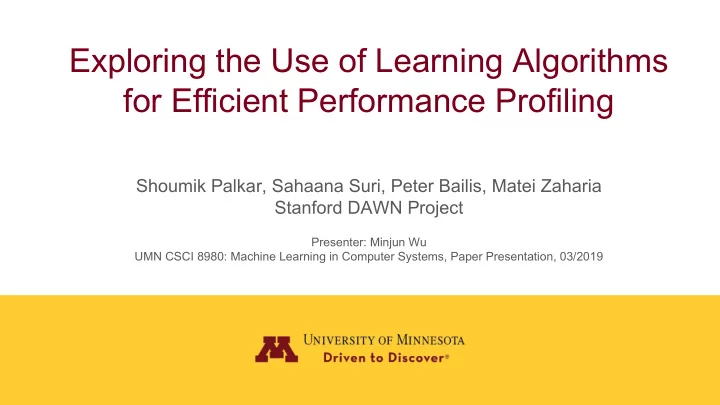

Exploring the Use of Learning Algorithms for Efficient Performance Profiling Shoumik Palkar, Sahaana Suri, Peter Bailis, Matei Zaharia Stanford DAWN Project Presenter: Minjun Wu UMN CSCI 8980: Machine Learning in Computer Systems, Paper Presentation, 03/2019
Find bottleneck in program Analyzing software production: - Python HTML parser - Different components (subcalls): start with, append, strip, split, match, find, others Profiler: - Signal interrupt => statistical profiler - Instrumenting code => tracing profiler
Existing methods Statistical Profiler: - Missing infrequent events - Too much for low variance events Tracing Profiler: - Overhead - Instrumentation tool
User target and opportunity User Target: - User wants to identify bottleneck - User doesn’t care too much about short running and low variance components Idea: - Measure more for longer running and high variance parts of program - Fewer time profiling for others
Paikana: choosing function calls to profile Paikana proposes two ways to choose: a. A racing algorithm: by statistical result b. Multi-armed bandits: more standard scenario A racing algorithm: - Choose component with minimum running time - Have enough confidence interval
Multi-armed bandits problem Problem description: You have K slot machines , and each machine provides a random reward from a probability distribution specific to that machine. The objective is to maximize the sum of rewards earned through a sequence of lever pulls. Problem analysis: “exploration” (try new action) v.s. “exploitation” (focus on seemingly highest reward one)
Multi-armed bandits problem (cont’) Standard solutions: - Naive: random try for a while then focus on the best - Thompson sampling: the best in confidence*winrate - UCB: choose high winrate and low variance Connection to profiling: - Exploration: profile subfunctions - Exploitation: profile more on user interested one (longer running time and high variance)
Paikana’s solution Successive Rejects algorithm from ref [2] (COLT 2010): “First the algorithm divides the time (i.e., the n rounds) in K − 1 phases . At the end of each phase, the algorithm dismisses the arm with the lowest empirical mean . During the next phase, it pulls equally often each arm which has not been dismissed yet. ” Parkana profile all candidates equally in each phase, then remove the least valuable one from the candidates.
Result Shown in two figures: - Runtime overhead: similar to statistical profiling (low) - Profiling accuracy: close to runtime profiler (high)
Discussion, my opinion Strength: - Combination between program profiling and multi-armed bandits problem - Insight: users focus on bottleneck components Weakness: - Components probability distribution model - Different testing scenarios, e.g. burst v.s. Stable, or bottleneck migrations (on the fly taking back)
Thanks!
Recommend
More recommend